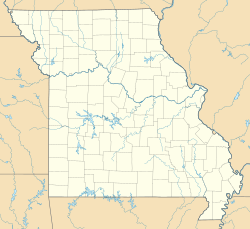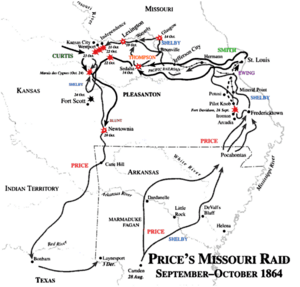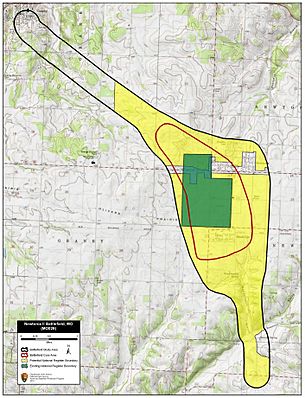Second Battle of Newtonia Site facts for kids
Quick facts for kids |
|
|
Second Battle of Newtonia Site
|
|
| Nearest city | Newtonia, Missouri |
|---|---|
| Area | 560 acres (230 ha) |
| NRHP reference No. | 04000698 |
| Added to NRHP | December 23, 2004 |
The Second Battle of Newtonia Site is a historic battlefield. It is located near the towns of Newtonia and Stark City in Missouri. This site is special because it is listed on the National Register of Historic Places (NRHP). This means it is an important place in American history.
The battle happened in late 1864 during the American Civil War. A Confederate general named Sterling Price led his army into Missouri. He hoped to draw Union soldiers away from other important battles. After losing a big battle called the Battle of Westport, Price's army was retreating. Union soldiers caught up to them near Newtonia.
The battle started when Union troops attacked. Confederate cavalry, led by Joseph O. Shelby, fought back well at first. But when more Union soldiers arrived, the Confederates had to pull back. The Union troops did not chase them right away. This allowed Price's men to escape. They eventually made it all the way to Texas.
In 2004, the battle site was officially added to the NRHP. Most of the battlefield is still well-preserved today.
Contents
The Story Behind the Battle
The Civil War and Price's Big Plan
By September 1864, the American Civil War had been going on for years. Things were not going well for the Confederates. They had lost a major battle in Atlanta. This helped Abraham Lincoln, who wanted to keep fighting, in the 1864 election.
A Confederate general named Edmund Kirby Smith was in charge of troops west of the Mississippi River. He was told to send his soldiers to help in the eastern parts of the war. But this was impossible. The Union Navy controlled the Mississippi River. No large army could cross it.
So, General Smith decided on a different plan. He would launch an attack to distract Union troops. This would be like helping the main war effort. General Sterling Price and Missouri's Confederate Governor, Thomas Caute Reynolds, suggested invading Missouri. Smith agreed and put Price in charge.
Price hoped his invasion would cause people in Missouri to rise up against the Union. He also wanted to pull Union soldiers away from other battles. Many Union troops had already left Missouri. The state's main defense was its local militia. Price also hoped his raid would help George B. McClellan win the election against Lincoln. Price's army entered Missouri on September 19.
Price's Retreat and More Battles
Price's army, called the Army of Missouri, first wanted to capture St. Louis. But they lost a battle at Pilot Knob in late September. This made them decide not to attack St. Louis. Their next target was Jefferson City, the state capital. But it was too strong to attack in early October.
So, the Confederates started moving west towards Kansas City. Along the way, they gathered supplies. Meanwhile, Union General William Rosecrans began gathering troops to fight Price.
By October 23, Union General Samuel Ryan Curtis and his army caught up with Price. They badly defeated him at the Battle of Westport. Price's army then began retreating through Kansas. But they had to fight three more battles: Marais des Cygnes, Mine Creek, and Marmiton River. The Battle of Mine Creek was a huge loss for the Confederates. They lost many supplies and soldiers.
On October 28, Price stopped his retreat near Newtonia, Missouri. He wanted to give his tired soldiers a rest.
The Second Battle of Newtonia
Price's main camp was south of Newtonia. A small line of Confederate soldiers was west of the town. Union General James G. Blunt's troops arrived around 2:00 PM. They started firing their cannons. The Confederates were surprised.
General Joseph O. Shelby quickly got his cavalry soldiers off their horses to fight Blunt's attack. Both sides formed lines and began firing cannons at each other. Blunt had six cannons, and Shelby had two. Shelby soon ordered his men to attack.
The Union soldiers on the right side held their ground. But part of the Confederate line went around the left side of Blunt's army. The Union soldiers had to fall back. They regrouped near the Mathew H. Ritchey farm. One Union cannon battery moved to a new spot northwest of town. Shelby's men got ready for another attack.
Blunt was running low on ammunition. He was thinking about retreating. But then, more Union soldiers arrived. These were led by General John B. Sanborn.
Sanborn's soldiers lined up next to Blunt's. After his cavalry got off their horses, Sanborn ordered an attack. Blunt's men were encouraged and joined the fight. More Union cannons had arrived with Sanborn. Now, the Confederates were outnumbered eight cannons to two.
Facing a stronger, attacking enemy, Shelby ordered his men to retreat. A small group of Confederate soldiers arrived to help Shelby, but it was too late. The Confederates pulled back to some woods south of Newtonia. The Union soldiers did not chase them. General Curtis and Blunt decided to wait until the next morning. Their men were too tired.
Both Blunt and Shelby later said they won the battle. The number of soldiers hurt or killed is not exactly known. One source says 26 Union soldiers and 24 Confederates. A newspaper from that time reported 113 Union casualties and "less than 200" Confederates.
After Newtonia, Price continued his retreat. He reached Arkansas by October 30. Curtis chased him until Price reached the Arkansas River on November 8. Price's army did not stop retreating until they reached Texas. By December, less than one-third of the soldiers Price started with were left in his army.
The Battlefield Site Today
The Second Battle of Newtonia Site was added to the National Register of Historic Places (NRHP) on December 23, 2004. Even though the town of Stark City has grown, much of the land is still used for farming.
The battlefield itself has changed a bit over time. A railroad was built through it in the early 1900s. Also, some leftover materials from mining are on the site. But these are not very noticeable. Some old roads and stone walls from 1864 are gone. However, the overall look of the land is still similar to how it was during the battle. A road runs through the southern part of the site. It offers good views of the battlefield.
The site includes four main historic areas. The first is the battlefield itself. Most of the main fighting area is here. It covers about 0.87 square miles (2.25 square kilometers). Most of this land is privately owned. Some parts of the battle happened further south, but those areas are not well-preserved. So, they are not part of the NRHP site.
The second area is the Ritchey cornfield. In 1864, Mr. Ritchey farmed 56 acres (23 hectares) of corn. Today, 26 acres (11 hectares) of this field are part of the historic site. This cornfield is still used for farming.
North of the main battle area is the third historic spot. This is where Union cannons were placed on a ridge. The last area is the old Granby Road. The road itself is gone. But its path has been found by archaeologists. You can also see a line of hedges where it used to be.
Besides these main areas, there are also some buildings on the site. These include a bakery, a machine shop, a silo, and 17 houses and other small buildings. These are mostly on the edges of the site. The site's boundaries include most of the important parts of the battlefield. The Second Battle of Newtonia Site is separate from the First Battle of Newtonia Historic District. But their boundaries touch in two places.
The American Battlefield Trust has helped protect 8 acres (3.2 hectares) at Newtonia. The Newtonia Battlefields Association also preserves more land. After the site was listed on the NRHP, the National Park Service (NPS) studied it. They wanted to see if it should become an official NPS unit. The study found the site was well-preserved. But it was not considered important enough to be an NPS site. It was not seen as a key example of the Civil War, Price's Raid, or General Price's importance.
|





